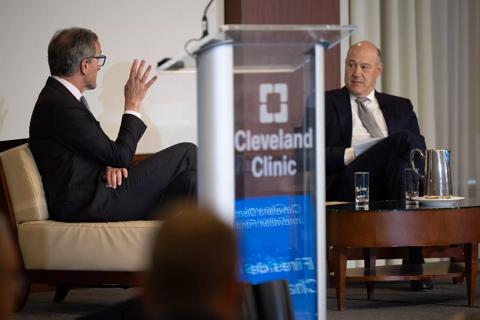What we’re doing at Cleveland Clinic

By Toby Cosgrove, MD
Advertisement
Cleveland Clinic is a non-profit academic medical center. Advertising on our site helps support our mission. We do not endorse non-Cleveland Clinic products or services. Policy
Over 75 percent of opioid and heroin deaths begin with a prescription painkiller. It is clear that, as physicians, we must approach pain differently. We have a key role in turning the tide of the opioid epidemic, and we cannot wait for Washington.
Declaring the opioid crisis a National Public Health Emergency is a good first step. But as physicians, we have approaches at our disposal that can effect very real change.
Better policies have been shown to make a difference quickly. In just the past few months, we’ve:
Given effective tools like these, physicians and other healthcare providers can make a lasting impact. This is one of four ways we can attack the epidemic. The others are insisting on team engagement among hospital departments; tracking prescribing data and demanding accountability; and sharing information with other hospitals in the region.
Our EHR has been an indispensable tool. It has allowed us to connect directly to the Ohio Automated Rx Reporting System (OARRS); now, a physician can see a patient’s history of controlled substances within seconds while formulating a treatment plan. Also, our patient-provider agreements and consents are stored electronically so anyone who cares for that patient can see it, review it and update it as appropriate.
Advertisement
At the same time, we can use the EHR to gather data so that we truly understand current practice. What type of patients are being prescribed narcotics? Which departments prescribe opioids most often? We study these questions, find answers and then use that data to standardize care across the system.
Here are a few more approaches we’re using at Cleveland Clinic:
Advertisement
The good news is that the fight against the opioid epidemic is moving in the right direction. With the right tools in place, physicians can have an enormous impact on the outcomes of this epidemic.
Dr. Cosgrove is CEO and President of Cleveland Clinic.
Advertisement
Advertisement

Advanced software streamlines charting, supports deeper patient connections

How holding simulations in clinical settings can improve workflow and identify latent operational threats

Interactive Zen Quest experience helps promote relaxing behaviors

Cleveland Clinic and IBM leaders share insights, concerns, optimism about impacts

Cleveland Clinic partners with Palantir to create logistical command center

A Q&A with organizational development researcher Gina Thoebes

Cleveland Clinic transformation leader led development of benchmarking tool with NAHQ

Raed Dweik, MD, on change management and the importance of communication